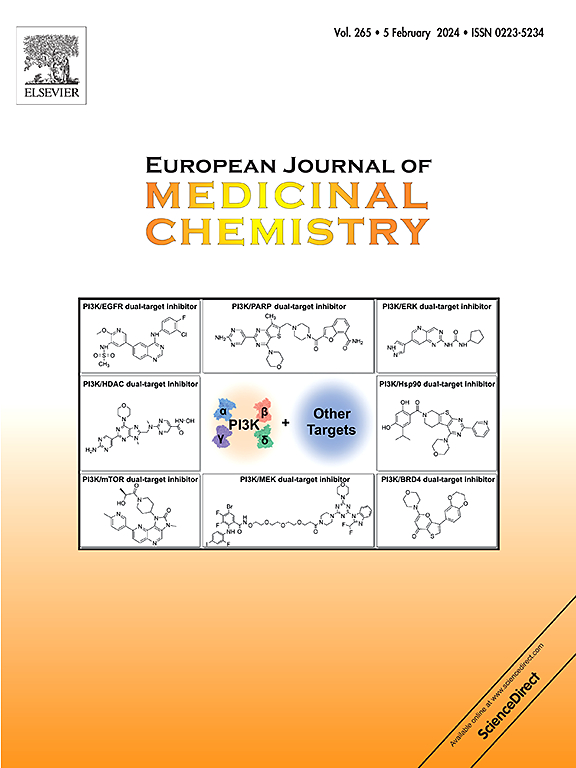CHI3L1-targeted small molecules as glioblastoma therapies: Virtual screening-based discovery, biophysical validation, pharmacokinetic profiling, and evaluation in glioblastoma spheroids
IF 6
2区 医学
Q1 CHEMISTRY, MEDICINAL
引用次数: 0
Abstract
Glioblastoma (GBM) remains the most aggressive primary brain malignancy with a 10 % three-year survival rate. Chitinase-3-like protein 1 (CHI3L1) has emerged as a critical factor in the progression of GBM progression, invasion, and treatment resistance. However, small molecule inhibitors targeting CHI3L1 are largely unexplored. Microscale thermophoresis (MST) investigation of the direct binding potential of reported CHI3L1 modulators (K284, G721–0282, CHI3L1-IN-1) revealed modest to undetectable direct CHI3L1 binding affinity. Herein, pharmacophore-based virtual screening of in-house library resulted in the discovery of G28 as the most potent small molecule CHI3L1 binder reported to date. The CHI3L1 binding affinity of G28 was validated using MST and surface plasmon resonance (SPR). To evaluate the GBM-modulatory potential of G28, we conducted comprehensive pharmacokinetic and 3D spheroid studies alongside established CHI3L1 modulators. G28 demonstrated outstanding bioavailability and low toxicity, addressing key limitations faced by previous CHI3L1-targeted strategies. Notably, in 3D GBM spheroid models, G28 significantly outperformed reported CHI3L1 small molecule modulators, showing the most pronounced dose-dependent reductions in spheroid weight, migration, and viability. These findings position G28 as the most promising CHI3L1-targeted small molecule to date and a compelling candidate for GBM therapeutic development.


chi3l1靶向小分子治疗胶质母细胞瘤:基于虚拟筛选的发现、生物物理验证、药代动力学分析和胶质母细胞瘤球体的评估
胶质母细胞瘤(GBM)仍然是最具侵袭性的原发性脑恶性肿瘤,三年生存率为10%。几丁质酶-3样蛋白1 (CHI3L1)已成为GBM进展、侵袭和治疗耐药的关键因素。然而,靶向CHI3L1的小分子抑制剂在很大程度上尚未被开发。报道的CHI3L1调节剂(K284, G721-0282, CHI3L1- in -1)的直接结合电位的微尺度热电泳(MST)研究显示,CHI3L1的直接结合亲和力适度至不可检测。在此,基于药物团的内部文库虚拟筛选结果发现G28是迄今为止报道的最有效的小分子CHI3L1结合剂。通过MST和表面等离子体共振(SPR)验证了G28的CHI3L1结合亲和力。为了评估G28对gbm的调节潜力,我们对已建立的CHI3L1调节剂进行了全面的药代动力学和3D球体研究。G28表现出出色的生物利用度和低毒性,解决了以往chi3l1靶向策略面临的主要限制。值得注意的是,在3D GBM球体模型中,G28明显优于CHI3L1小分子调节剂,在球体重量、迁移和活力方面显示出最明显的剂量依赖性降低。这些发现表明G28是迄今为止最有希望的靶向chi3l1的小分子,也是GBM治疗发展的有力候选者。
本文章由计算机程序翻译,如有差异,请以英文原文为准。
求助全文
约1分钟内获得全文
求助全文
来源期刊
CiteScore
11.70
自引率
9.00%
发文量
863
审稿时长
29 days
期刊介绍:
The European Journal of Medicinal Chemistry is a global journal that publishes studies on all aspects of medicinal chemistry. It provides a medium for publication of original papers and also welcomes critical review papers.
A typical paper would report on the organic synthesis, characterization and pharmacological evaluation of compounds. Other topics of interest are drug design, QSAR, molecular modeling, drug-receptor interactions, molecular aspects of drug metabolism, prodrug synthesis and drug targeting. The journal expects manuscripts to present the rational for a study, provide insight into the design of compounds or understanding of mechanism, or clarify the targets.

 求助内容:
求助内容: 应助结果提醒方式:
应助结果提醒方式:


